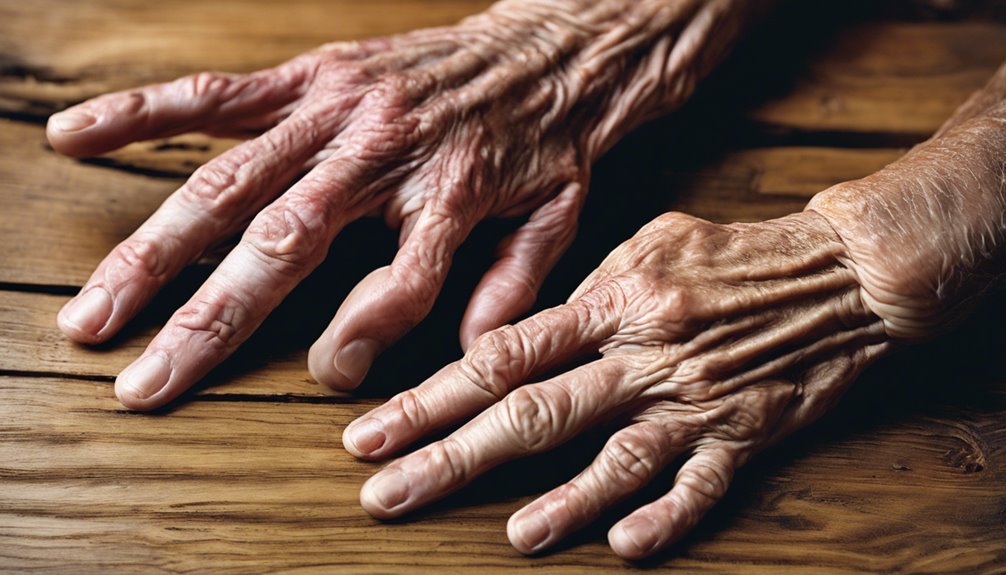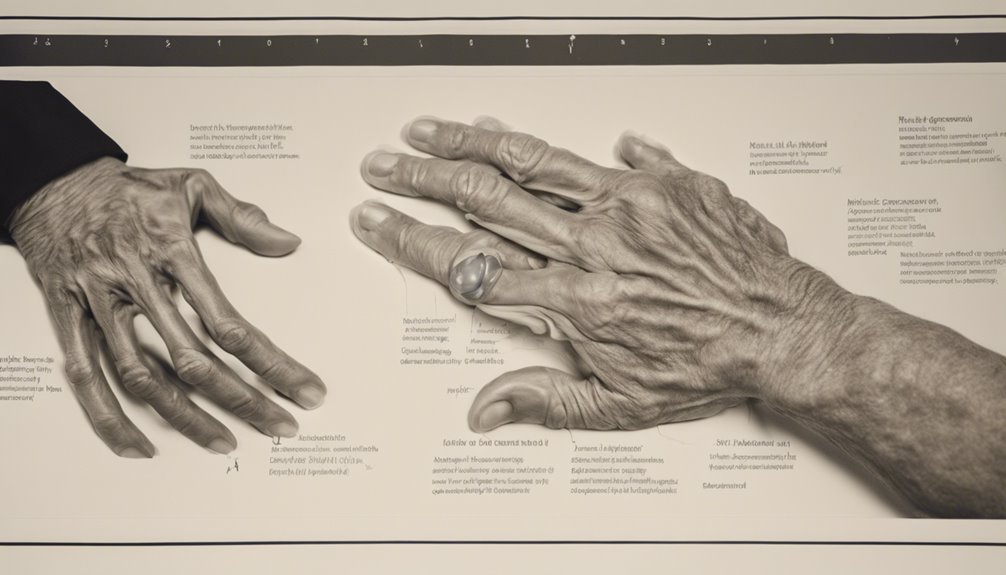When you think about arthritis, you might lump osteoarthritis and rheumatoid arthritis together, but they’re distinct. Osteoarthritis is mainly about wear and tear on your joints, leading to pain and stiffness over time. Rheumatoid arthritis, however, involves your immune system mistakenly attacking your joints, causing inflammation and potential joint deformities. Understanding these differences is essential for recognizing symptoms and seeking appropriate treatment. But how do these conditions impact your daily life, and what lifestyle changes could help manage them effectively? Let’s explore these aspects further.
Key Takeaways
- Osteoarthritis is a degenerative joint disease caused by wear and tear, while rheumatoid arthritis is an autoimmune disease causing systemic inflammation.
- Osteoarthritis symptoms include localized joint pain and stiffness; rheumatoid arthritis causes symmetrical joint pain with systemic effects, such as fatigue.
- Morning stiffness in osteoarthritis lasts less than 30 minutes, whereas in rheumatoid arthritis, it lasts over an hour.
- Osteoarthritis is diagnosed using X-rays to detect joint space narrowing; rheumatoid arthritis uses blood tests for inflammatory markers and MRI for detailed imaging.
- Osteoarthritis treatment focuses on pain relief and mobility, while rheumatoid arthritis treatment uses DMARDs to slow disease progression.
Understanding Osteoarthritis

Although many consider arthritis a single condition, it encompasses various joint disorders, including osteoarthritis (OA). OA is a degenerative joint disease primarily resulting from wear and tear on cartilage, especially in weight-bearing joints like the knees and hips.
You might notice joint pain that worsens over time, with stiffness after activity, swelling, and a grinding or cracking sensation when moving the affected joints.
Several risk factors increase your chances of developing OA. Age is a significant factor, as the likelihood of experiencing OA rises as you get older. Obesity contributes to OA by placing additional stress on your joints, especially those that support your body weight.
Joint injuries from accidents or repetitive use can also lead to the development of OA. Additionally, you may be genetically predisposed to the condition if you have a family history of OA.
Unlike rheumatoid arthritis, OA usually begins gradually and often affects isolated joints rather than appearing symmetrically.
Managing OA focuses on pain relief and maintaining mobility. Various methods, including NSAIDs, physical therapy, and lifestyle changes, are used to minimize discomfort and maintain joint function.
Understanding Rheumatoid Arthritis
Rheumatoid arthritis (RA) is an autoimmune disease that, unlike osteoarthritis, involves the immune system mistakenly attacking the synovial membrane. This leads to chronic inflammation and joint damage. This condition doesn’t just target joints; it can also cause systemic effects like fatigue, fever, anemia, and loss of appetite. RA typically affects the same joints on both sides of the body, often involving the small joints in your hands and feet.
A sudden onset with morning stiffness lasting more than an hour is a common sign of rheumatoid arthritis. Early diagnosis is essential for managing symptoms and preventing joint destruction. Doctors often prescribe disease-modifying antirheumatic drugs (DMARDs) to slow the disease’s progression and improve outcomes. Here’s a quick look at some key aspects of RA:
| Symptom | Description | Impact |
|---|---|---|
| Joint Pain | Symmetrical, often in small joints | It affects mobility and daily activities |
| Systemic Effects | Fatigue, fever, anemia, loss of appetite | Overall health and energy levels |
| Morning Stiffness | It lasts more than an hour | Indicates inflammation severity |
| Treatment | DMARDs and early intervention | It prevents joint damage and improves life quality |
Understanding these elements can help you recognize and manage rheumatoid arthritis effectively.
Causes of Each Condition

When considering the causes of osteoarthritis and rheumatoid arthritis, you’ll find they’re fundamentally different.
Osteoarthritis arises from the wear-and-tear of cartilage, often linked to aging, repetitive stress, or joint injuries.
In contrast, rheumatoid arthritis occurs when the immune system mistakenly attacks the joints, causing inflammation and damage.
Osteoarthritis Wear-and-Tear Origin
One might wonder what causes the gradual deterioration seen in osteoarthritis. Unlike rheumatoid arthritis, where the immune system attacks the joints, osteoarthritis is all about wear and tear. The relentless friction and pressure on your joints gradually wear down the cartilage, which is a cushion. This is especially true for weight-bearing joints like the knees and hips. The everyday grind, whether from overuse at work or repetitive activities, can take a toll.
Other factors also come into play:
- Age and Obesity: As you age, your joints naturally undergo more wear and tear. Extra weight adds more pressure, accelerating cartilage breakdown.
- Previous Injuries: If you’ve had joint injuries in the past, they can set the stage for osteoarthritis by damaging cartilage or altering joint alignment.
- Genetic Predisposition: If osteoarthritis runs in your family, you’re more likely to experience it, too.
The degenerative nature of osteoarthritis leads to the breakdown of cartilage, resulting in pain and stiffness. Over time, this can cause bone spurs and changes in the joint structure.
Rheumatoid Autoimmune Attack Mechanism
Unlike osteoarthritis’s wear-and-tear origins, rheumatoid arthritis (RA) springs from an autoimmune attack. In RA, your immune system mistakenly targets the synovial membrane, the lining of your joints, leading to chronic inflammation. This misguided immune response doesn’t just stop at one joint; it can affect multiple joints throughout your body, causing pain and swelling.
Over time, this persistent assault on the synovial membrane can result in considerable joint damage, potentially leading to deformities and loss of function.
The exact cause of RA remains elusive, but several risk factors might increase your chances of developing it. Genetic predisposition plays a role, meaning if RA runs in your family, you might be more susceptible. Hormonal influences and environmental triggers, like smoking or exposure to certain chemicals, also contribute.
Unlike osteoarthritis, which is localized to joint pain and stiffness, RA’s autoimmune nature can cause systemic effects. You might experience symptoms beyond your joints, such as fatigue and fever.
Early detection and intervention are essential in RA. Recognizing the autoimmune attack before it progresses can meaningfully alter the disease’s trajectory, preventing severe joint damage and maintaining a better quality of life.
Common Symptoms
Understanding the distinctions between osteoarthritis (OA) and rheumatoid arthritis (RA) requires recognition of the common symptoms of each.
When it comes to rheumatoid arthritis, you’ll often notice it affects the small joints symmetrically, especially the hands and feet. This common type of arthritis leads to widespread joint pain and stiffness, with symptoms persisting for more than 30 minutes, often exceeding an hour in the morning.
Unlike OA, RA can involve systemic effects like fatigue, fever, and loss of appetite, making it more complex and challenging to manage.
Conversely, osteoarthritis typically presents with localized joint pain and stiffness that worsens with activity and improves with rest. This stiffness usually lasts less than 30 minutes after periods of inactivity.
OA often begins in weight-bearing joints like the knees and hips, and unlike RA, it can affect joints asymmetrically. While joint deformities and swelling are significant in RA, OA primarily leads to joint pain and potential osteophyte formation without considerable swelling.
Here’s a quick rundown to help distinguish between them:
- OA: Localized pain improves with rest
- RA: Systemic symptoms, small joints affected
- Stiffness Duration: Less than 30 minutes vs. more than an hour
Diagnostic Techniques

Diagnostic techniques are essential in differentiating between osteoarthritis (OA) and rheumatoid arthritis (RA). Understanding these processes can help you get the right diagnosis as you work with your healthcare provider. For OA, the diagnosis usually relies on physical examinations and X-ray imaging. These X-rays can reveal cartilage loss and joint space narrowing, key indicators of OA. On the other hand, diagnosing RA involves specific blood tests. These tests look for inflammatory markers, such as rheumatoid factor (RF) and anti-citrullinated protein antibodies (anti-CCP), typical in RA.
Sometimes, when X-rays don’t provide enough information, an MRI might be used for both conditions. This detailed imaging technique assesses soft tissue and joint damage more thoroughly. Your healthcare provider will also consider your patient history and symptoms. While OA often presents with localized pain, RA may show systemic symptoms like fatigue and prolonged morning stiffness.
| Osteoarthritis (OA) | Rheumatoid Arthritis (RA) |
|---|---|
| Physical examination | Blood tests (RF, anti-CCP) |
| X-ray imaging | MRI for detailed imaging |
| Localized pain | Systemic symptoms |
| Cartilage loss | Inflammatory markers |
An accurate diagnosis is essential for OA and RA to improve management and prevent further joint damage.
Treatment Strategies
When it comes to managing arthritis, both osteoarthritis (OA) and rheumatoid arthritis (RA) require tailored treatment strategies to address their distinct characteristics.
For OA, your focus will be pain relief and improving joint function. Medications like nonsteroidal anti-inflammatory drugs (NSAIDs) and acetaminophen can help ease the discomfort. Physical therapy is another key component, helping you maintain mobility and strength.
In more severe OA cases, surgical options such as joint replacement might be necessary to restore mobility and alleviate pain.
On the other hand, the approach to treating RA is a bit different. Here, the goal is to slow disease progression and reduce immune system activity using disease-modifying antirheumatic drugs (DMARDs). These are often combined with NSAIDs and corticosteroids to manage inflammation effectively.
To sum up, here’s a quick look at some treatment essentials:
- OA Focus: Pain relief with NSAIDs, acetaminophen, and physical therapy.
- RA Focus: Slowing progression with DMARDs, plus NSAIDs and corticosteroids.
- Surgical Options: Considered for severe OA to restore joint function.
Lifestyle Adjustments

Regular low-impact exercise, such as walking or swimming, can greatly enhance joint function and reduce pain for those managing either osteoarthritis (OA) or rheumatoid arthritis (RA). These activities not only improve mobility but also contribute to overall health.
Alongside exercise, maintaining a healthy weight is essential. Excess weight stresses weight-bearing joints in OA and can exacerbate inflammation in RA. By shedding extra pounds, you can reduce pain and enhance joint health.
Another key lifestyle adjustment is quitting smoking, especially if you have RA. Smoking is a known risk factor that can worsen symptoms and even decrease the effectiveness of treatments. As a result, stopping smoking can greatly improve your health outcomes.
Incorporating physical and occupational therapy into your routine can also make a notable difference. These therapies focus on enhancing mobility, improving daily function, and offering strategies for joint protection, helping you lead a more active life.
Finally, a diet rich in anti-inflammatory foods like fruits, vegetables, whole grains, and omega-3 fatty acids can help manage symptoms. This dietary approach addresses inflammation and supports overall health, benefiting individuals with both OA and RA.
Impact on Daily Life
While lifestyle adjustments like exercise and diet can enhance joint health, living with osteoarthritis (OA) or rheumatoid arthritis (RA) still presents daily challenges.
OA often causes localized pain and stiffness, especially in weight-bearing joints. This makes walking, climbing stairs, or enjoying sports tough. The pain can worsen with activity, and though it might improve with rest, it considerably impacts daily life by limiting physical mobility.
RA, on the other hand, often causes systemic symptoms like fatigue and malaise, impacting your energy levels. This can make it hard to keep up with routine tasks or maintain a regular work schedule. Joint deformities associated with RA can further complicate daily activities, impairing hand function and making it challenging to perform fine motor tasks such as writing or buttoning clothes.
Here’s how both conditions can affect your day-to-day:
- Morning stiffness: RA sufferers often experience prolonged morning stiffness, which can delay the start of your day.
- Pain with activity: OA pain typically worsens with activity but improves with rest, affecting your ability to stay active.
- Emotional challenges: Chronic pain and unpredictable flare-ups in RA can lead to emotional stress.
Understanding these impacts is essential in managing arthritis effectively.
Seeking Medical Advice

Seeking medical advice is fundamental when dealing with joint pain, stiffness, or swelling. These symptoms can indicate osteoarthritis or rheumatoid arthritis, and distinguishing between the two is essential for receiving the right treatment. Rheumatoid arthritis, an autoimmune condition, requires a different approach than osteoarthritis, primarily a degenerative joint disease. By consulting a healthcare professional early, you can guarantee an accurate diagnosis and prevent further joint damage.
Experienced rheumatologists play an important role in differentiating these conditions. They use blood tests to look for inflammatory markers that suggest rheumatoid arthritis and imaging studies to assess joint health and structure. Your patient history is also invaluable in guiding their decisions. Promptly seeking medical advice allows you to explore treatment options tailored to your needs, enhancing your quality of life.
Access to specialized care, such as extensive musculoskeletal centers, can greatly improve management outcomes. These centers offer a holistic approach and effectively address osteoarthritis and rheumatoid arthritis.
Frequently Asked Questions
How Do I Know if It’s Osteoarthritis or Rheumatoid Arthritis?
You can compare symptoms and consider treatment options. Risk factors and disease progression help differentiate. OA usually has localized pain, while RA shows systemic effects. Consult a doctor for a definitive diagnosis and personalized management plan.
What Is the Life Expectancy of a Person With Rheumatoid Arthritis?
With rheumatoid arthritis, your life expectancy can align with the general population if you manage symptoms effectively. Use treatment options, make lifestyle changes, and manage flare-ups early to improve your longevity and quality of life.
What Are the Diagnostic Criteria for Osteoarthritis?
You diagnose osteoarthritis through clinical evaluation, focusing on symptom assessment, such as joint pain and stiffness. To confirm changes, you use diagnostic imaging, such as X-rays. To tailor management, you consider treatment options based on patient-specific factors and radiographic findings.
What Not to Do With Osteoarthritis?
Don’t ignore exercise limitations; avoid high-impact activities. Watch your dietary considerations to help with weight management. For pain management, limit NSAID use without a doctor’s advice. Protect your joints by using proper techniques and avoiding heavy lifting.
Conclusion
To understand the differences between osteoarthritis and rheumatoid arthritis, remember that OA is a degenerative joint disease caused by wear and tear. At the same time, RA is an autoimmune disorder causing systemic inflammation. It is essential to recognize their unique causes, symptoms, and diagnostic needs. Treatment strategies vary, but they focus on symptom relief and improving quality of life. Don’t ignore persistent joint pain or stiffness; seek medical advice to tailor a management plan that suits your needs and enhances daily living.

